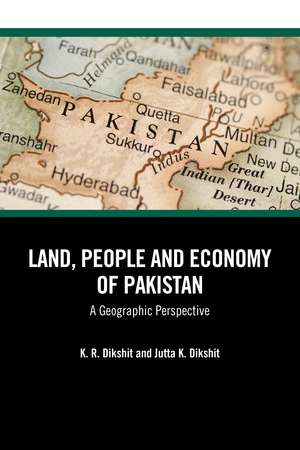Land, People and Economy of Pakistan: A Geographic Perspective
Autor K. R. Dikshit, Jutta K. Dikshiten Limba Engleză Paperback – 18 feb 2025
This volume discusses the distribution of natural resources and deciphers the evolutionary development of manufacturing, transport and trade, the main non-agricultural enterprises, and looks at the potential for their growth. It provides an overview of the country`s economy and its fluctuations through different political regimes. It also investigates the country’s diverse social, linguistic, and ethnic composition. A habitat study, incorporating villages and towns, their numerical and spatial distribution, and the hierarchical organization of rural society, has received a special focus in the book.
The book, with its qualitative and quantitative information, will be useful to students, teachers and researchers studying physical geology, climatology, hydrology, soil science, environmental studies, archaeology, sociology, economics, demography, area studies and regional development studies. It will also be an indispensable companion to professionals in floral-landscaping, habitat study, administrators, and policy makers.
Preț: 425.68 lei
Nou
Puncte Express: 639
Preț estimativ în valută:
81.47€ • 84.33$ • 68.86£
81.47€ • 84.33$ • 68.86£
Carte nepublicată încă
Doresc să fiu notificat când acest titlu va fi disponibil:
Se trimite...
Preluare comenzi: 021 569.72.76
Specificații
ISBN-13: 9781032835952
ISBN-10: 1032835958
Pagini: 440
Ilustrații: 76
Dimensiuni: 156 x 234 mm
Greutate: 0.68 kg
Ediția:1
Editura: Taylor & Francis
Colecția Routledge India
Locul publicării:Oxford, United Kingdom
ISBN-10: 1032835958
Pagini: 440
Ilustrații: 76
Dimensiuni: 156 x 234 mm
Greutate: 0.68 kg
Ediția:1
Editura: Taylor & Francis
Colecția Routledge India
Locul publicării:Oxford, United Kingdom
Public țintă
PostgraduateCuprins
1. Introduction Part I: Physical Geography of Pakistan 2. Geology, Structure, Physical Build and Relief Features of Pakistan 3. Drainage Network: The Rivers of Pakistan 4. Bioclimatic Background: Climate, Soil, Vegetation and Natural Hazards Part II: People of Pakistan 5. Religion, Ethnicity, Language and Culture of the People of Pakistan 6. Population of Pakistan 7. Rural Settlements in Pakistan 8. Urban Landscape: Cities and Towns Part: III Economy 9. Water Resources of Pakistan 10. Irrigation in Pakistan 11. Agriculture in Pakistan 12. Energy Resources – Availability and Utilisation 13. Industrial Landscape of Pakistan 14. Transport and Trade 15. Economy of Pakistan: Changing Public Policy and its Impact on the Economy - An Overview Bibliography
Notă biografică
K.R. Dikshit is a former Professor of Geography of the University of Pune, India (now retired). He has written several books, such as “Geography of Gujarat” (1970), “Contribution to Indian Geography: Geomorphology” (ed-1983), “Maharashtra in Maps” (1986), “Environment, Forest Ecology and Man in the Western Ghats: The Case of Mahabaleshwar Plateau” (1993) and “North-East India: Land, People and Economy” (2014) as well as many research papers.
Jutta K. Dikhit has been teaching geography at the Department of Geography of the University of Pune, Pune. She studied geography and German language and literature at the Johannes Gutenberg University., Mainz (Germany), and obtained her doctoral degree from the Sorbonne, Paris. Before coming to India, she worked as a lecturer at the University of Saarbrucken for a number of years. Her research papers are mainly in the field of physical geography. She is the editor of the book “The Urban Fringe of Indian Cities” (2011) and she is co-author of the book “North-East India: Land, People and Economy” (2014).
Jutta K. Dikhit has been teaching geography at the Department of Geography of the University of Pune, Pune. She studied geography and German language and literature at the Johannes Gutenberg University., Mainz (Germany), and obtained her doctoral degree from the Sorbonne, Paris. Before coming to India, she worked as a lecturer at the University of Saarbrucken for a number of years. Her research papers are mainly in the field of physical geography. She is the editor of the book “The Urban Fringe of Indian Cities” (2011) and she is co-author of the book “North-East India: Land, People and Economy” (2014).
Descriere
The book unravels the complexity of Pakistan’s physical terrain, from the Arabian Sea coast to the Himalayan heights, focusing on its bio-climatic environment. While discussing the evolution of societal organization and economic enterprises, it shows human response to the way natural resources have been harnessed.
